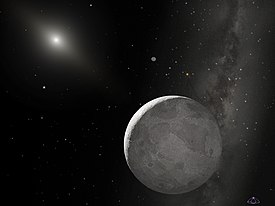 Eris and Dysnomia: Eris is the main object, Dysnomia the smaller disk just above it. The object top-left is the Sun (artist's impression). | |
| Discovery | |
|---|---|
| Discovered by | M. E. Brown, M. A. van Dam, A. H. Bouchez, D. Le Mignant[1] |
| Discovery date | September 10, 2005[1] |
| Designations | |
| MPC designation | (136199) Eris I Dysnomia |
| Alternate name | S/2005 (2003 UB313) 1 |
| Adjective | Dysnomian |
| Semi-major axis | 37 370 ± 150 km |
| Eccentricity | <> |
| Orbital period | 15.774 ± 0.002 d |
| Inclination | 142 ± 3° |
| Satellite of | Eris |
| Physical characteristics | |
| Equatorial radius | 50–150 km[3] |
| | |
Dysnomia (pronounced /dɪsˈnoʊmiə/, /dаɪsˈnoʊmiə/,[4] or as in Greek Δυσνομία), officially (136199) Eris I Dysnomia, is the only known moon of the dwarf planet Eris. It was discovered in 2005 by Mike Brown and the laser guide star adaptive optics team at the W. M. Keck Observatory, and carried the provisional designation of S/2005 (2003 UB313) 1 until officially named Dysnomia[5] (from the Ancient Greek word Δυσνομία meaning "lawlessness") after the daughter of the Greek goddess Eris.
Discovery

During 2005, the adaptive optics team at the Keck telescopes in Hawaii carried out observations of the four brightest Kuiper belt objects (Pluto, Makemake, Haumea, and Eris), using the newly commissioned laser guide star adaptive optics system. Observations taken on 10 September revealed a moon in orbit around Eris, provisionally designated S/2005 (2003 UB313) 1. In keeping with the Xena nickname that was already in use for Eris, the moon was nicknamed "Gabrielle" by its discoverers, after the television warrior princess' sidekick.[6][7]
Properties
The satellite is about 60 times fainter than Eris, and its diameter is estimated to be less than 150 km.[8] Combining Keck and Hubble observations, the satellite was used to constrain the mass of Eris, and orbital parameters were estimated. Its orbital period is calculated to be 15.774±0.002 d.[2] These observations indicate that Dysnomia orbits Eris at a distance of 37 370 ± 150 km.[2] This suggests that the mass of the system is approximately 1.27 times that of Pluto.[2]
Formation
Astronomers now know that three of the four brightest Kuiper belt objects (KBOs) have satellites, while among the fainter members of the belt only about 10% are known to have satellites. This is believed to imply that collisions between large KBOs have been frequent in the past. Impacts between bodies of the order of 1000 km across would throw off large amounts of material which would coalesce into a moon. A similar mechanism is believed to have led to the formation of Earth's own Moon when the Earth was struck by a giant impactor early in the history of the solar system.
Name
Mike Brown, the moon's discoverer, chose the name Dysnomia (Greek Δυσνομία) due to a number of resonances it possessed for him. Dysnomia, the daughter of Eris, fits the general historically established pattern of naming moons after lesser gods associated with the primary (hence, Jupiter's largest moons are named after lovers of Jupiter, while Saturn's are named after his fellow Titans). Also, the English translation of "Dysnomia", "lawlessness," echoes Lucy Lawless, the actress famous for starring in Xena: Warrior Princess on television. Before receiving their official names, Eris and Dysnomia were known informally as "Xena" and "Gabrielle" respectively (Gabrielle being Xena's sidekick), and Brown decided to retain that honour.
Brown also notes that Pluto owes its name in part to its first two letters, which form the initials of Percival Lowell, the founder of the observatory where its discoverer, Clyde Tombaugh, was working, and the person who inspired the search for "Planet X." James Christy, who discovered Charon, followed the principle established with Pluto by choosing a name which shared its first four letters with his wife's name, Charlene. "Dysnomia", similarly, has the same first letter as Brown's wife, Diane,[9] and Brown uses the nickname "Dy" /ˈdaɪ/ for the moon, which he pronounces the same as his wife's nickname, Di. Because of this, Brown pronounces the full name /dаɪsˈnoʊmiə/, with a long "y".[10]
In addition, both Eris and Dysnomia, representing aspects of chaos, reflect the effect their existence had in the disputation on the definition of a planet (and specifically on the status of Pluto and Ceres), and the debate that followed.
0 comments:
Post a Comment